The german blue ram is a small, attractive, and peaceful fish that has captured the attention of aquarists. Although it was discovered 30 years after its relative, the bolivian ram, the german blue ram has become a popular choice in the aquarium trade. Both species are dwarf cichlids, but the german blue ram is notably smaller, typically growing to about 5 cm in length, compared to the bolivian ram, which can reach up to 7 cm in its natural habitat. This makes the german blue ram an ideal choice for smaller tanks and community setups.
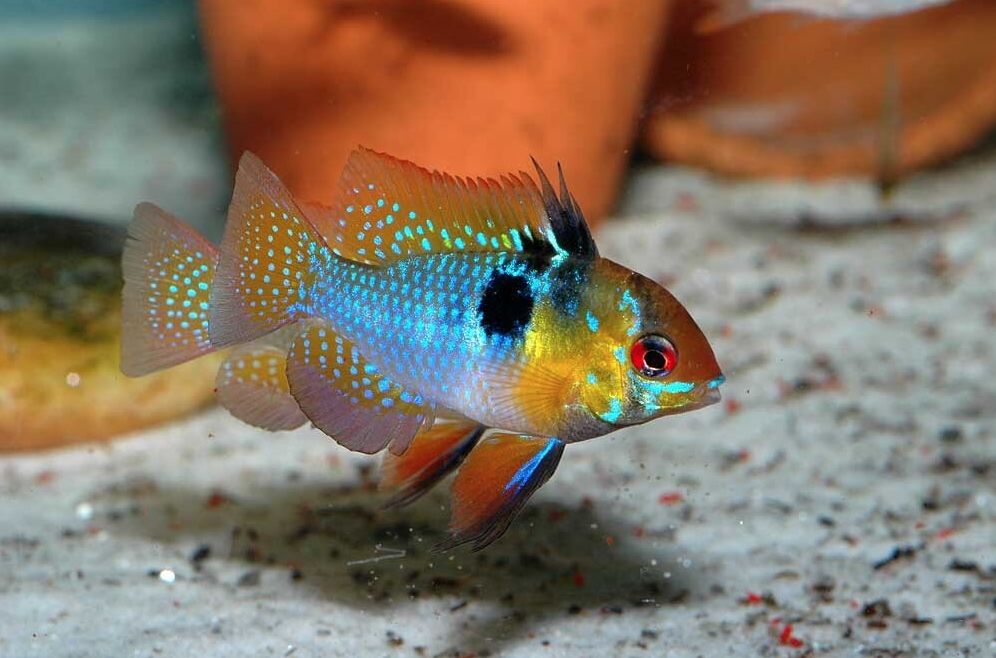
Contents
Habitat in the wild
The ram cichlid, scientifically known as Mikrogeophagus ramirezi, is a captivating member of the Cichlidae family, which is renowned for its diversity, vibrant colors, unique behaviors, and often complex breeding habits. Cichlids are commonly found in Africa, South and Central America, and certain regions of Asia, showcasing a remarkable range of adaptations. The ram cichlid was first described in 1948 and previously classified as Papilochromis ramirezi and Apistogramma ramirezi; it received its current name in 1998.
While the german blue ram is associated with South America, particularly the Amazon River basin, it is important to note that this fish is not found in the main river itself but rather in the myriad rivers and streams that flow into it. The species primarily inhabits the Orinoco River basin in Venezuela and Colombia, thriving in lakes and ponds characterized by still or slow-moving waters. Their preferred habitats feature sandy or muddy bottoms rich in vegetation. The german blue ram exhibits a fascinating foraging behavior, often digging through the substrate in search of plant matter and small insects, but they are also known to feed in the water column and occasionally take food from the surface.
| Characteristic | Description |
|---|---|
| Scientific Name | Mikrogeophagus ramirezi |
| Common Names | Ram cichlid, German Blue Ram, Ram fish, Ramirezi fish |
| Family | Cichlidae |
| Origin | South America (Orinoco River basin in Venezuela/Colombia) |
| Size | 2 to 3 inches (5 to 7.5 centimeters) |
| Lifespan | 2 to 3 years (can vary with proper care) |
| Temperament | Generally peaceful, but can become territorial during breeding |
| Coloration | Striking colors and intricate patterning |
| Sex Differences | Males are more colorful with extended dorsal fins |
| Habitat | Slow-moving waters with dense vegetation and sandy substrates |
| Tank Requirements | 20-gallon minimum for a pair, heavily planted with hiding spots |
| Water Parameters | Temperature: 77-82°F (25-28°C), pH: 6.0-7.0, hardness: soft to medium |
| Diet | Omnivorous – High-quality pellets, flakes, frozen, and live foods |
| Breeding Difficulty | Moderate (sensitive to water conditions during breeding) |
| Compatibility | Peaceful community fish with other non-aggressive species |
| Special Considerations | Sensitive to water quality changes, regular water changes needed |
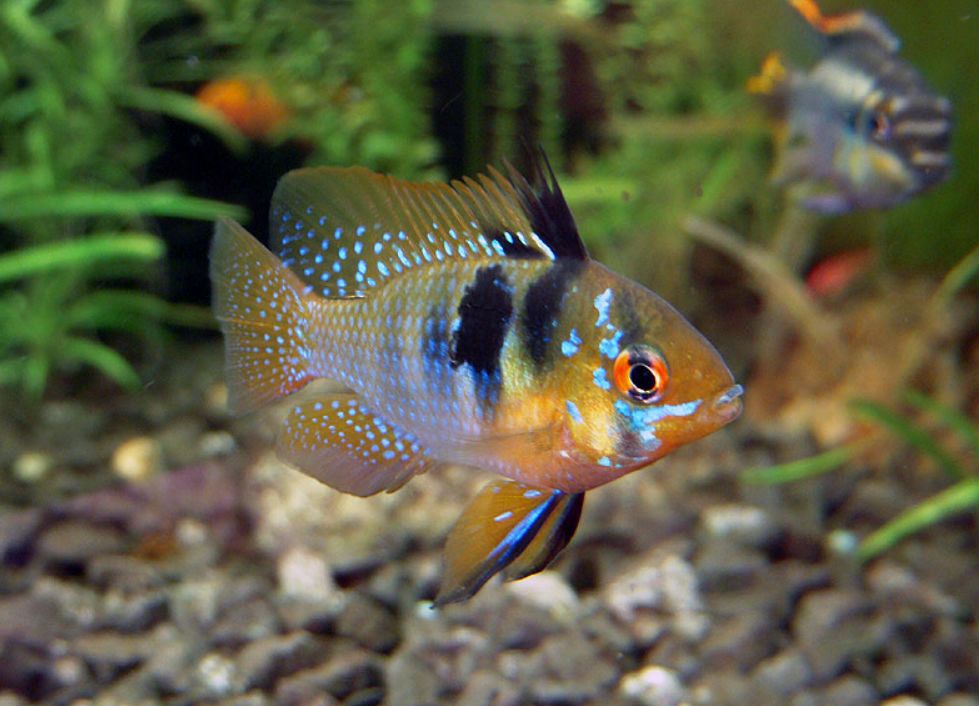
Description
Body
Appearance
The german blue ram is a small, vibrant cichlid characterized by its oval-shaped body and prominent fins. Its striking coloration includes bright red eyes, a yellow head, and a body adorned with shimmering blue and violet hues, highlighted by a distinctive black spot and vibrant fins. This stunning appearance makes the german blue ram a favorite among aquarists.
Size
The Mikrogeophagus ramirezi typically reaches about 2 to 3 inches (5 to 7.5 centimeters) in length when fully grown. Both males and females are generally similar in size, although males can be slightly larger and more vividly colored. This compact size makes them well-suited for smaller aquariums and community tanks alongside other peaceful species.
Lifespan
The lifespan of ram cichlids can vary with their care and living conditions, averaging around 2 to 3 years in a well-maintained aquarium. Providing optimal water quality, a balanced diet, and a stable environment can help ensure they reach their full lifespan potential.
Types of Ram Cichlids
There are several morphs of the german blue ram, including balloon, electric blue, and gold variants. While these colorful variations can confuse beginners, they all belong to the same species, albeit with different body shapes or colors. However, many of these morphs result from inbreeding, which can lead to weakened immune systems and increased susceptibility to diseases. Additionally, some sellers may use hormones to enhance the appearance of these fish before selling them, which can further impact their health.
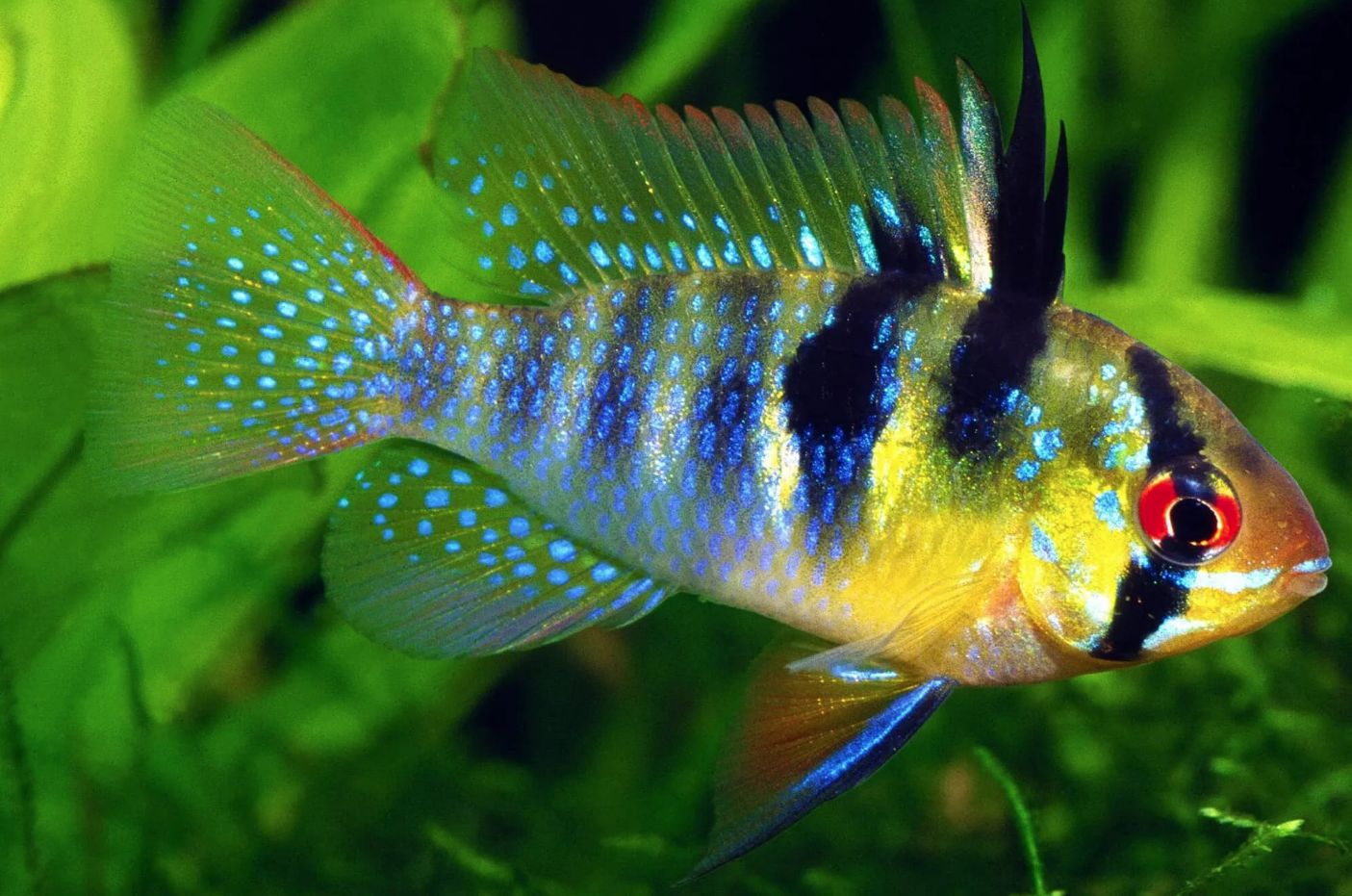
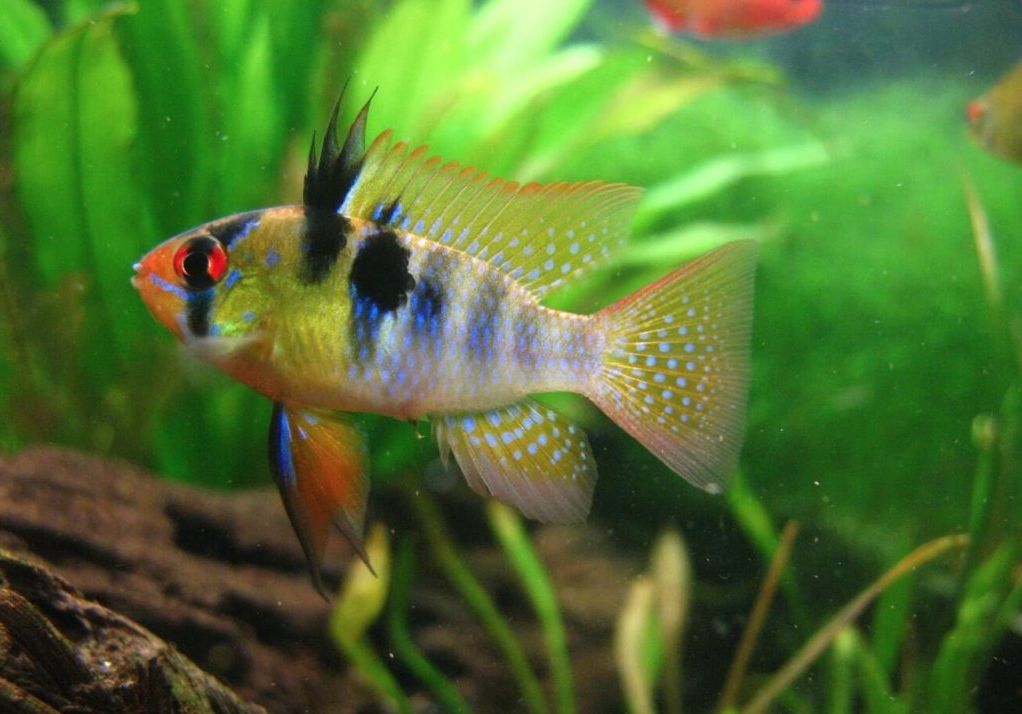
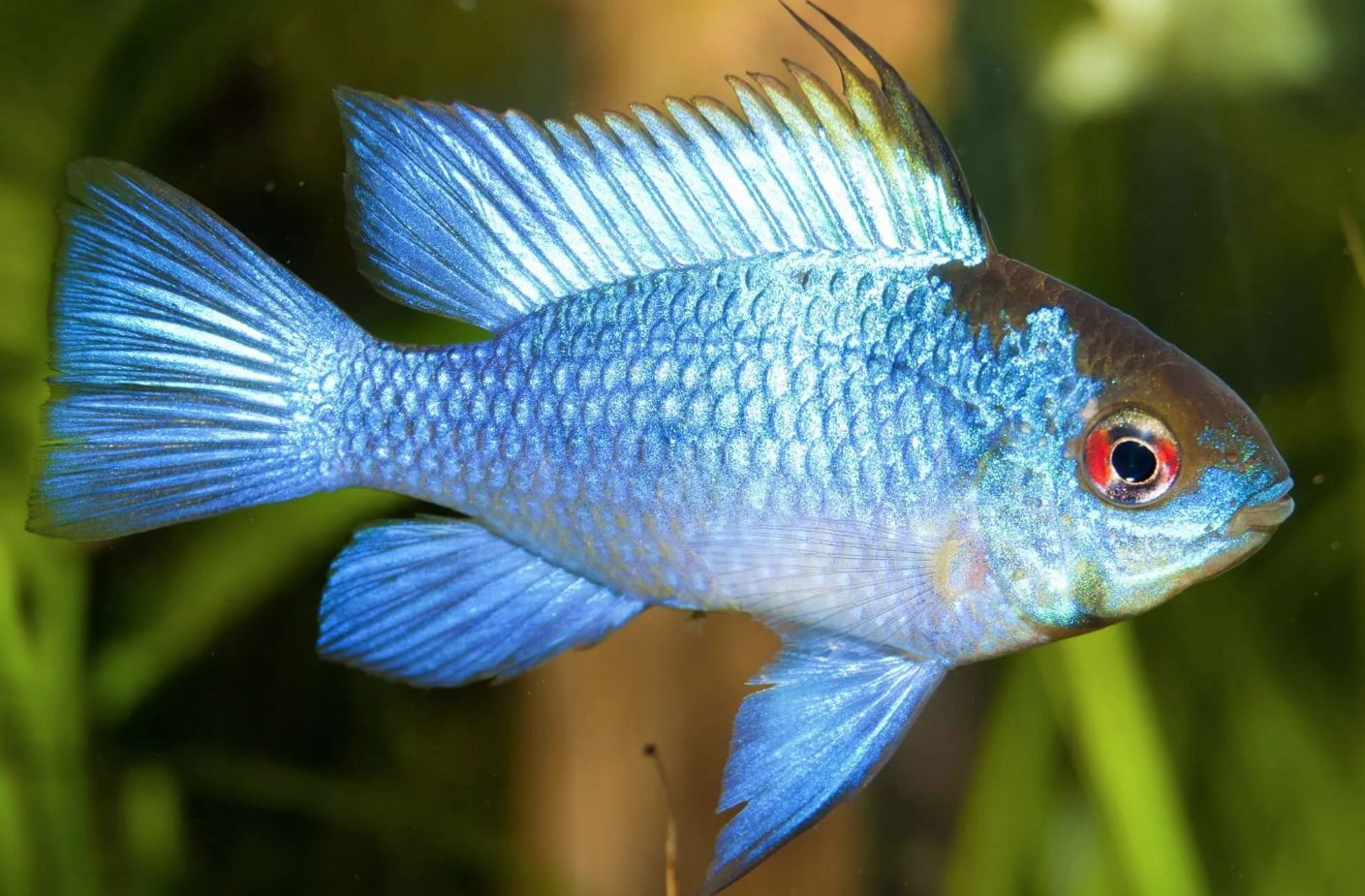
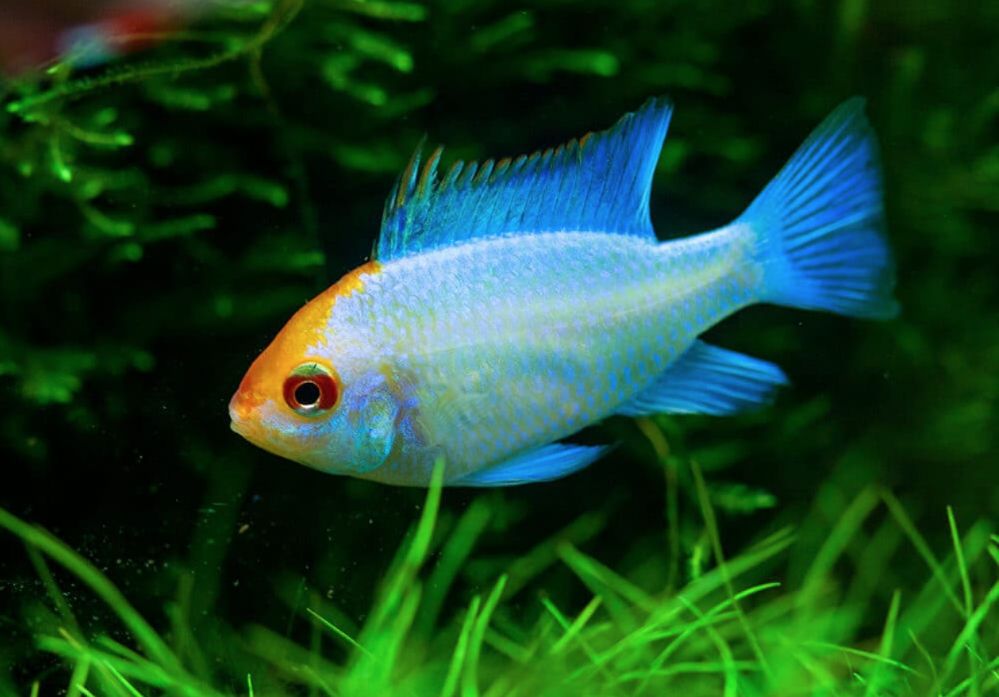

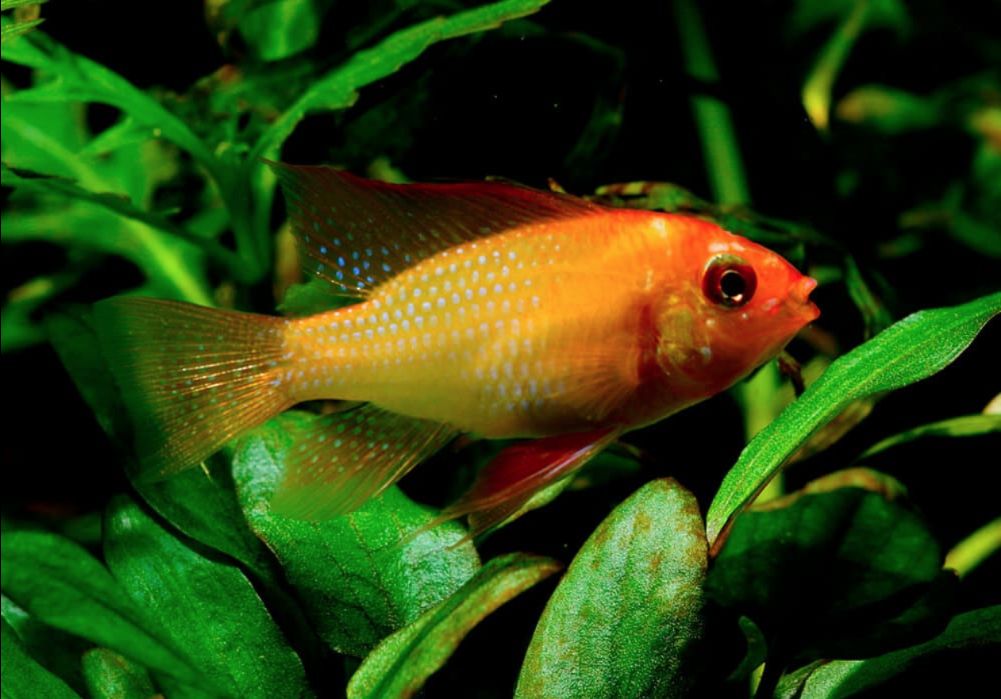
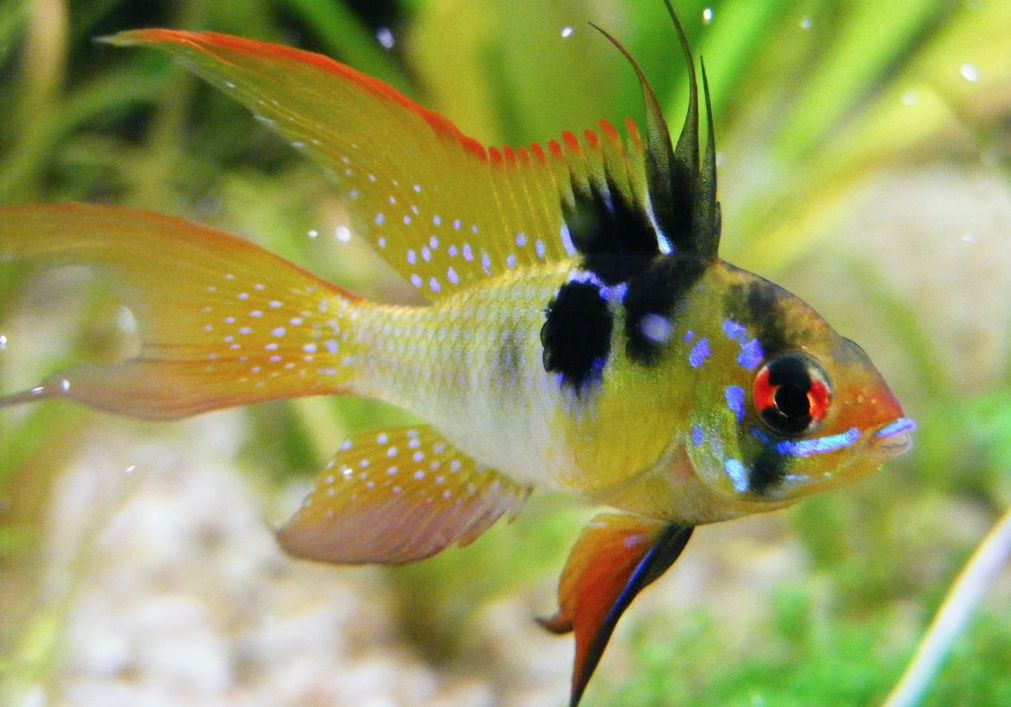

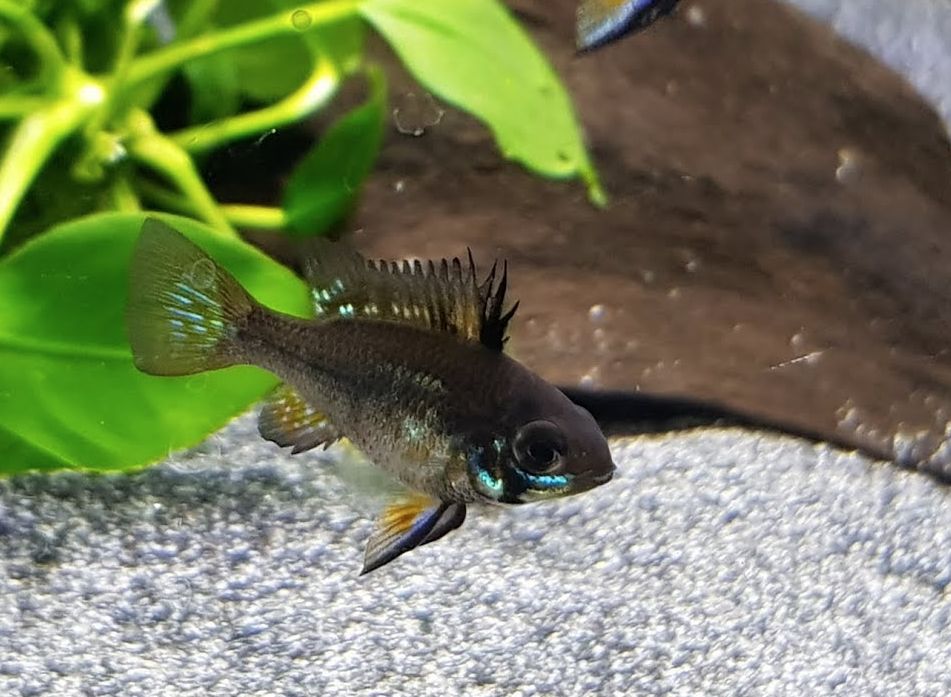
Difficulties in keeping
The ram cichlid is often regarded as one of the best options for aquarists looking to keep cichlid species in their tanks. The german blue ram, in particular, is small, peaceful, and remarkably colorful, making it an attractive choice for both novice and experienced fish keepers. They have a diverse diet and readily accept all types of food, which simplifies feeding.
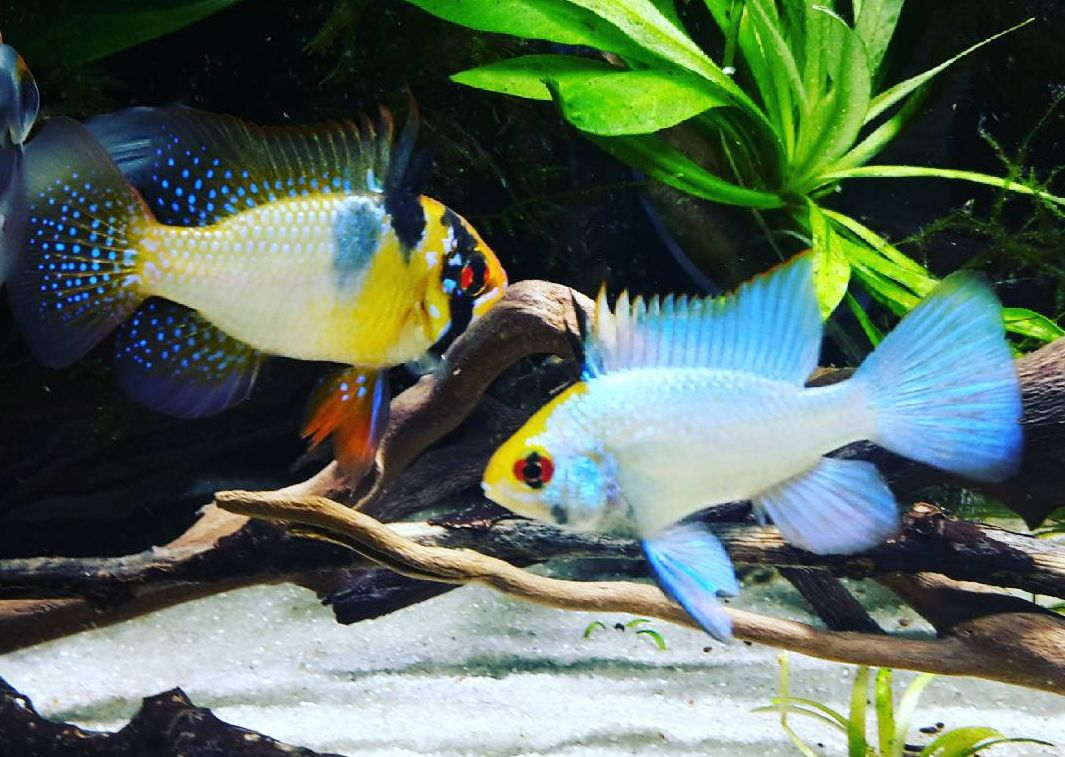
Care and keeping in a tank
Tank size
The recommended tank volume for german blue rams starts at 20 gallons, which is approximately 76 liters, allowing them enough space to swim and establish territories. While they can technically survive in smaller tanks, a larger volume significantly enhances their well-being and reduces stress. A 20-gallon (76-liter) tank provides a more stable environment, minimizing fluctuations in water parameters, which is crucial for these sensitive fish.
Water parameters
Now, the german blue ram can adapt well to the water parameters of its environment, but ideal conditions are essential for optimal health. The recommended temperature range is 77-82°F (25-28°C), reflecting the slightly warmer temperatures typical of tropical aquariums. For pH levels, maintaining a range of 6.0-7.0 allows these fish to thrive in slightly acidic to neutral conditions, which is vital for their overall well-being.
Water hardness should be soft to medium, with a general hardness (GH) level between 5-12 dGH. This range mimics their natural habitat and supports their health. It is critical to keep ammonia and nitrite levels at 0 ppm, as these compounds are toxic to fish. Nitrate levels should also be minimized, ideally below 20 ppm, achievable through regular water changes and effective filtration.
Efficient filtration is necessary to maintain water quality and remove waste products, as german blue rams can be sensitive to poor water conditions. Regular water changes, about 20-30% of the total tank volume each week, are crucial for removing accumulated pollutants and stabilizing parameters.
In addition to water conditions, ram cichlids appreciate a well-planted aquarium filled with hiding spots created by driftwood, rocks, and plants. These not only provide shelter but also aid in stabilizing water parameters by absorbing excess nutrients. It is important to remember that sudden changes in water parameters can stress ram cichlids, so any adjustments should be made gradually. Regular monitoring of water conditions will ensure the best environment for your ram cichlids to thrive.
Tank decor
The aquarium can be decorated in the style of its native river in the South America. Sand, lots of covers, flowerpots, snags and thick bushes. It is better to use sand and small gravel as a tank bottom, since german blue rams likes digging it.
You can put fallen leaves of the trees on the bottom to create the environment close to the wild one. Ram cichlid doesn’t like bright light and it’s better to put some fluctuant plants on the water surface.
Diet
German blue ram is an euryphagous fish, meaning it has a varied diet that includes both plant matter and small organisms found in its natural habitat. In the wild, these fish feed on a range of natural foods, such as detritus, algae, and tiny invertebrates. In a tank environment, they thrive on various types of live and frozen foods, including bloodworms, tubifex, and brine shrimp, which provide essential nutrients and promote vibrant coloration.
For optimal health and growth, german blue rams should be fed two times a day with small portions. This helps to prevent overfeeding and maintain water quality. While some cichlids may eat flakes and granules, german blue rams generally prefer more natural food sources and may not consume these types of feed as readily. Due to their timid nature, it’s crucial to ensure they are fed before more assertive tank mates arrive to compete for food, allowing them to eat comfortably and without stress.
It’s also beneficial to incorporate a variety of foods into their diet to promote a balanced nutritional profile. Supplementing their meals with high-quality pellets specifically designed for cichlids can provide additional vitamins and minerals. Additionally, introducing blanched vegetables, such as spinach or zucchini, can mimic their natural foraging behavior and add fiber to their diet.
Monitoring their eating habits is essential; if they consistently refuse certain foods, it may indicate stress or illness. Regular feeding schedules and a diverse diet can enhance the overall health and well-being of german blue rams, allowing them to display their full range of colors and behaviors.
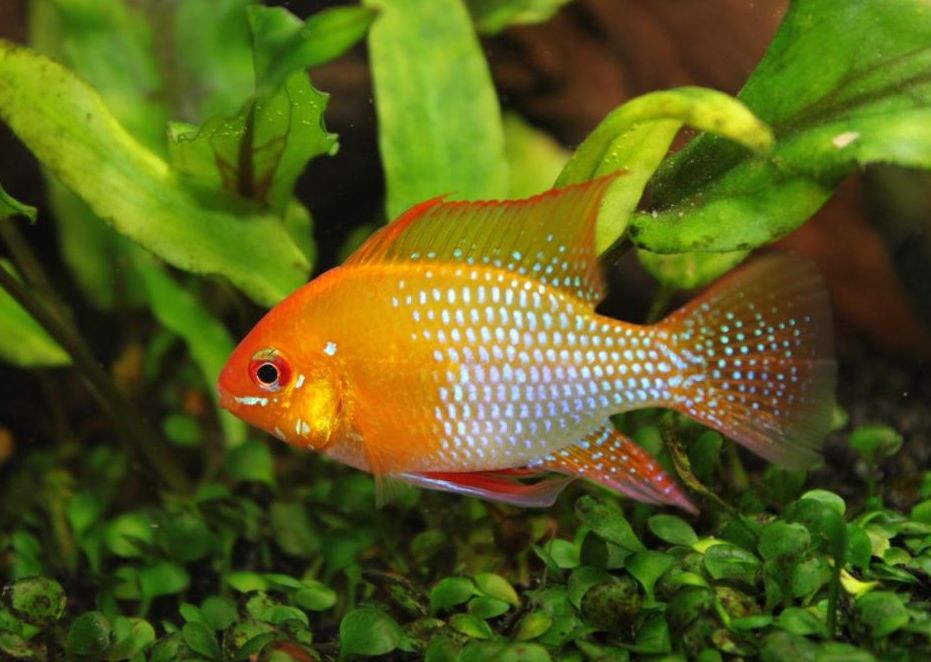
Tank mates
Ram cichlid can live in a community tank together with peaceful and not large tank mates. Live-bearing fish such as: guppies, swordtails, mollies and platy, as well as different Characins: black neon tetra, bloodfin tetra, rummy-nose tetra, neon tetra, can be good tank mates.
As for interaction with shrimps, it’s important to note that while german blue rams are small, they are still cichlids. They typically ignore larger shrimp, but smaller ones may be perceived as potential food. Therefore, it’s generally advisable to avoid keeping tiny shrimp species with these cichlids to prevent any predation.
German blue rams can thrive both as solitary fish and in pairs. If you plan to keep several pairs, it’s essential to provide a spacious tank with plenty of hiding spots, as these fish, like all cichlids, are territorial. When establishing territories, they will defend their space against perceived intruders. However, if you purchase a pair, it doesn’t guarantee they will breed. Breeding pairs often form from a group of juveniles, as they will select their own mates based on compatibility.
While german blue rams can exhibit aggressive behaviors, such as displaying or chasing, this is typically more about asserting dominance than an actual intention to harm. These displays are usually meant to scare off intruders from their territory rather than initiate an attack. It’s crucial to monitor their interactions with other tank mates and ensure that all fish have enough space to establish their own territories, which will help maintain peace within the aquarium.
Gender differences: male vs female
German blue rams, like many cichlid species, exhibit sexual dimorphism, meaning there are distinct visual differences between males and females. Here are some key differences:
Males are generally larger than females, reaching lengths of up to 2.5 to 3 inches (6.5 to 7.5 centimeters), while females typically grow to around 2 to 2.5 inches (5 to 6.5 centimeters). The most noticeable difference is in coloration; males display brighter and more vibrant hues, particularly during breeding, with intense blue and yellow shades. Their dorsal and anal fins tend to be more elongated and pointed compared to females.
During breeding and territorial displays, males may exhibit darker markings, especially on their gill covers and throat areas, which can manifest as black spots or lines. Additionally, males often have a more streamlined and elongated body shape, while females may appear slightly rounder.
Behaviorally, males can be more territorial and aggressive, especially during the breeding season as they defend their chosen spawning sites. Males may also develop breeding tubes on their ventral area, just in front of their anal fin, which are absent in females.
While these characteristics are typical, individual variations can occur, influenced by age, health, and overall condition.
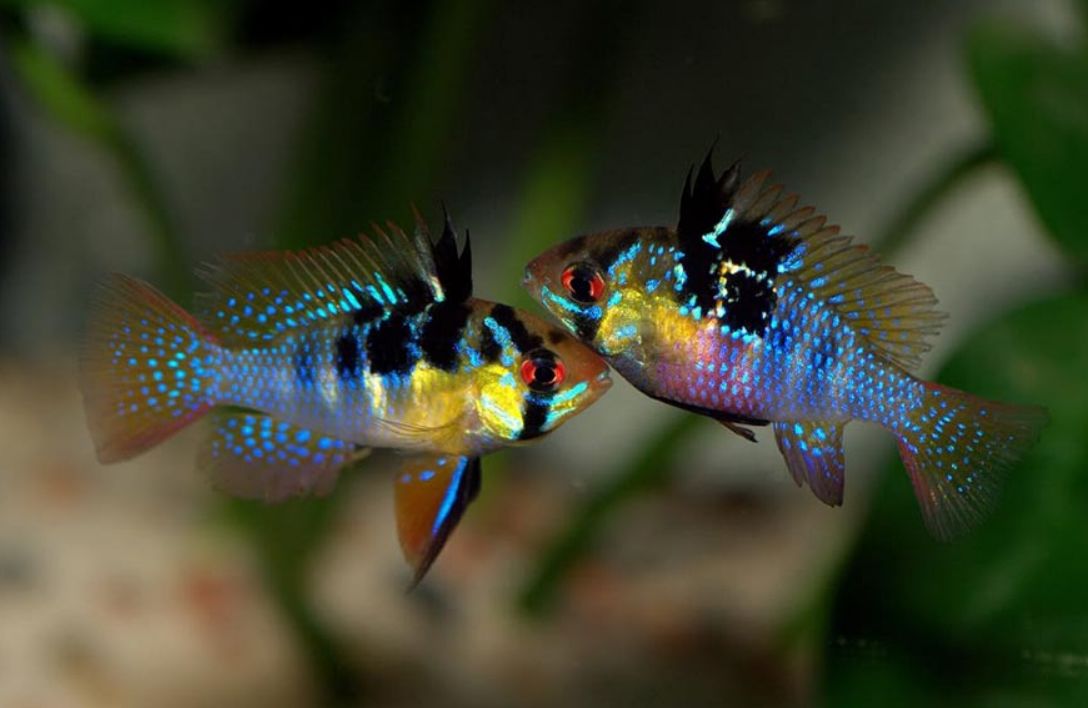
Breeding
The first challenge that aquarists often encounter when breeding german blue rams is a well-known issue among angelfish enthusiasts: the impact of keeping cichlids in a tank on their parental instincts. Many breeding pairs may completely disregard their eggs, often destroying them just hours after spawning.
Another significant challenge is the vulnerability of the eggs to bacterial and fungal infections. Eggs that lack parental care can quickly succumb to saprolegniosis, leading to high mortality rates. Addressing these challenges is crucial for successful cichlid breeding.
To breed german blue rams, a container with a base area of approximately 300 square centimeters and a height of about 15 centimeters is sufficient. The container should be thoroughly cleaned before use, and a thin layer of clean sand or small gravel (1-2 centimeters) should be added to the bottom. Fill the container with water and allow it to settle. While using reverse osmosis water is ideal, it’s important to let the water sit for 3-4 days before introducing the fish. The water level should be kept at 8-10 centimeters, simulating their natural spawning conditions in shallow waters.
Choosing the right substrate is essential; ideally, it should resemble the substrate used in the community tank. This familiarity helps reduce the time needed for the fish to adapt, speeding up the breeding process. German blue rams often spawn not only in open areas but also on the walls of caves, flowerpots, or other hiding spots, reflecting the preferences of the specific pair.
The water in the breeding tank should be slightly more acidic (by about 0.1-0.3 units) and warmer (by about 1-2 °C) compared to the community tank. It must also be chlorine-free, with water hardness not exceeding 10 °dGH and a pH close to neutral. Light intensity can be adjusted to suit the preferences of the breeders.
While aeration is not strictly necessary, a slow water flow is recommended to avoid disrupting the eggs. This can be achieved using a long tube sprayer placed a few centimeters below the water surface, allowing for gentle circulation without strong currents that could displace the eggs.
During the spawning period, german blue rams should be fed once daily with small portions of live foods, such as bloodworms or white worms. Frozen and dry foods should be avoided to minimize the risk of pulping, which can hinder successful spawning. After about 2-3 days of acclimation, the breeding process typically begins.
Depending on the breeders’ age and readiness, a single spawning can produce anywhere from 70 to 400 oval eggs. Male german blue rams play a more active role in guarding the eggs, often remaining close by and patrolling the territory. Their parental duties include fanning the eggs to ensure proper water circulation, removing debris, and tending to any dead eggs. Occasionally, a parent may take an egg into its mouth, inspect it, and return it to the substrate.
The ich fry have a large yolk sac that sustains them for the first 5-7 days. During this time, they remain on the substrate, with parents returning any fallen fry to safety. Once the fry are ready to swim, the male will begin to move them into prepared pits on the bottom, guiding them several times a day. By this stage, the female is typically removed from the spawning tank, while the male continues to care for the fry, teaching them to feed.
Initial feeding can consist of microworms or infusoria, and after several days, it’s advisable to transfer the male back to the community tank while moving the fry to a separate, bare-bottomed tank. This setup simplifies cleaning, as fry are sensitive to waste accumulation. Regular siphoning is necessary to remove uneaten food and waste, with fresh water added to maintain optimal conditions.
If artificial incubation is chosen, the process is similar, except that decorations and substrate are not required initially. Eggs collected from a community tank should be handled delicately to avoid damaging their fragile shells. Keeping the eggs submerged is vital to prevent exposure to air.
It’s crucial to maintain stable water flow and substrate orientation during this process. Raising the temperature in the incubator can help expedite the hatching process, with some references suggesting a maximum temperature of 36 °C to minimize the risk of saprolegniosis. After hatching, the temperature should be gradually lowered to standard levels.
While some fry may survive from the incubated eggs, they can be weaker than those raised in optimal conditions. Even under favorable conditions, a significant percentage of juveniles may not reach marketable size. Generally, about one-third of the total hatch may not survive to a length of about 2 centimeters.
Despite these challenges, the high fertility rate of german blue rams usually compensates for losses, allowing for a sustainable population in the aquarium. Juveniles begin to show color during their third month but achieve full coloration only around 90-100 days of age. They can be introduced to the community tank once they reach 1-1.5 centimeters, provided this does not lead to overcrowding. Ideally, keeping them separate until they reach maturity allows for better monitoring of their growth and well-being.